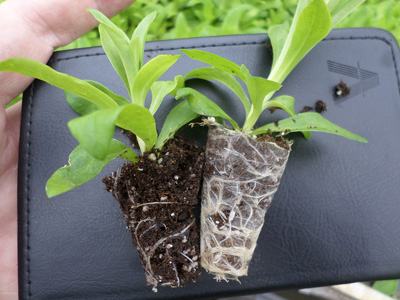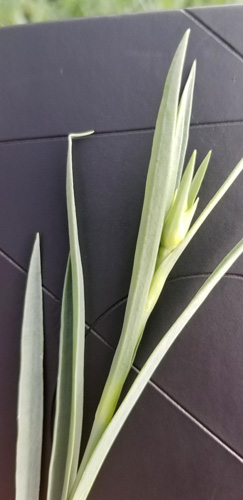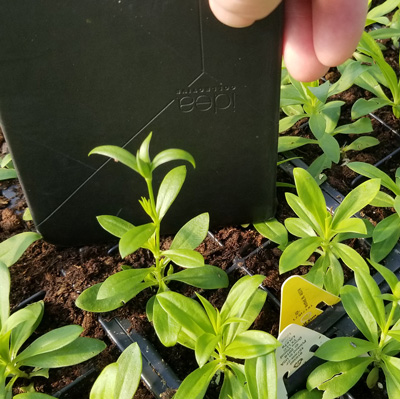12/1/2022
Dianthus Explained, Part 2
Dr. Will Healy

Innovative dianthus varieties created during the last 200 years have used a wide range of species. Dianthus varieties are probably the most extensively interspecific bred plants in modern floriculture. The modern interspecific varieties are easier to grow and more adaptable to a wider range of conditions for consumers. The previous article on dianthus in the November issue of GrowerTalks categorized the commercially available dianthus into the four primary markets. This article will focus on the key factors for success with dianthus.
Pictured: A highly branched root system (right) versus a wet soil root system (left).
When developing a cultural program for any plant, it’s important to understand where the species originated. The species’ habitat provides critical information on how to successfully grow the plants since “You can take the plant out of the country, but you can’t take the country out of the plant.” Dianthus barbatus, D. chinensis and D. caryophyllus are the three dominant species in modern varieties. These and many other species are native to the Mediterranean and western Asia regions. The dianthus in these regions are naturalized in well-drained, fertile soils and are spring flowering under high light conditions. These conditions create the critical framework for successful production of dianthus.
Soil, fertilizer & water
The dianthus root system is a very fine and highly branched “fuzzy” root system. A “happy” dianthus root system is very well branched and a mass of white when removed from the container. This makes sense, as they’re native to well-drained soils. The plants develop an extensively branched root system to absorb water and nutrients. The dianthus root system needs to “breathe,” so a saturated soil isn’t good. A soil that will dry down to a level 2 every two to three days is the ideal soil for producing dianthus. Soils that hold water or growing areas with poor drainage that keep the soil constantly wet will result in poor quality roots that are prone to disease issues.
Although dianthus will tolerate high rates of fertilizer, quality plants are grown using constant 100 to 150 ppm N until flowers start to show color. Periodic fertilizing requires 200-plus ppm N for adequate growth. A balanced ammonia-containing fertilizer during early growth will encourage branching. High rates of ammonia nitrogen during low light conditions will cause the plants to be soft and stretched. When growing under low light conditions, increasing the potassium levels in the fertilizer will increase the plant tone.
 Pictured: Bent leaf tip indicator of Boron deficiency.
Pictured: Bent leaf tip indicator of Boron deficiency.
Dianthus are calcium- and boron-loving plants that require higher-than-normal application rates to prevent flower and foliage malformation. Add adequate limestone to maintain a pH of 6.0 to 6.5. The limestone will supply adequate calcium for normal growth. During periods of high RH when transpiration is poor, adding boron to the fertilizer solution is recommended. The fertilizer solution should have 0.5 to 0.75 ppm B to prevent boron deficiency. Early boron deficiency is easy to observe, as the leaf tip bends back on itself.
The biggest mistake growers make with dianthus is incorrect water management. Dianthus are intolerant of “wet feet.” Research in the 1970s clearly showed a strong correlation between improper watering and spindly growth, Fusarium infection or root rot diseases. Pythium infection increases when dianthus roots are saturated due to poorly drained soil, constant watering or sitting in wet areas. Pythium infection exposes the plants to subsequent Fusarium infection. Controlling Pythium is a key way to control Fusarium. Once dianthus are systemically infected with Fusarium, plant quality and salability declines rapidly.
To prevent Pythium infection during early plant establishment, allow the soil to dry to a level 2 before watering back up to a level 4. Check the bottoms of the container to make sure that the soil on the bottom is not saturated, as this is where the disease issues begin.
Light
Dianthus is a high light requiring plant. The highest quality plants are produced when the DLI is >10 mol per day. Outdoor production results in compact plants with the greatest number of flowers. During periods with low DLI, reduce the night temperature to 40 to 50F (5 to 10C) to slow growth to minimize weak, spindly growth. Plants grown under low light conditions and night temperatures >60F (15C) require PGR applications to produce a compact plant. Application of Ancymidol (A-Rest) or paclabutrazol (Bonzi) on young plants and in early spring on finished plants is effective. Review the variety-specific PGR recommendations for rates and application method (spray versus drench) since varieties respond differently to PGRs.
Many dianthus species flower rapidly under long days and branch vegetatively when the photoperiod is <12 hours. Older varieties required >12-hour photoperiod to induce flowers. The new interspecific varieties are selected for year-round flowering, which reduces the need for long day treatment of the finished plants. Plants finishing during the fall/winter periods will flower earlier if given a 12- to 14-hour photoperiod of supplemental light. Once plants are induced with seven to 10 long days, additional long day treatment isn’t needed. Avoid long day conditions >14 hours during the early stages of plug and liner production since this can promote early flowering with poor branching. It’s easy to tell if the shoot is induced since the youngest leaf length and width are reduced.
Temperature
Growing dianthus at cool temperatures results in the highest quality plants. When grouping plants, dianthus should always be grown with the pansy/violas. Dianthus varieties will tolerate near freezing temperatures, so planting early and growing cold will result in the highest quality with the best flowering display. Research shows that flower number, size and color are improved at cool night growing conditions. With low DLI levels, dropping the night temperatures can improve plant quality.
The optimum temperatures for young plants (plugs and rooted cuttings) and finished production are available in the Ball RedBook and supplier culture guides. There are slight differences depending on variety, so consult the culture guides for optimum temperatures. The key difference between young plant production and finished production is that the young plants are grown warmer than the finished production. Consider using a morning DIP to control stem stretch by lowering the daytime temperature after sunrise by up to 10F (5C) and letting the temperature naturally climb as the day progresses.
When growing perennial dianthus (D. gratianopolitanus, D. deltoides) or D. barbatus, consider a six-plus week treatment of 40 to 45F (5 to 8C) nights to provide a vernalization treatment to enhance flowering. This cold treatment is usually done as an overwintering treatment where the plants are started in the fall and allowed to develop a strong root system prior to the cold treatment. The newer interspecific varieties benefit from this low temperature treatment, but it’s not required like with the older varieties.
Pest management
Every crop has its Achilles’ heel and dianthus has a couple to watch out for! With correct water management, dianthus is one of the easier crops to grow, but failure to manage the moisture will result in multiple disease issues.
Besides the Pythium/Fusarium issue due to wet soils, minimize how long the foliage stays wet. Foliar and flower diseases (Alternaria, rust and Botrytis) can spread rapidly when the canopy is closed and free water is on the foliage. When high RH and dark conditions are present, application of appropriate fungicides is strongly recommended. Wet soil conditions require an appropriate fungicide drench to control Pythium. Poorly fertilized plants are prone to disease issues, so feed throughout the crop cycle. Reduce the ammonia-based fertilizers by switching to nitrate-based fertilizers once canopies close to increase plant tone.
 Pictured: Premature flowering (left) vegetative plant.
Pictured: Premature flowering (left) vegetative plant.
Fungus gnats and shore flies are seldom a problem when watering practices are correct. Thrips, on the other hand, are a major pest of dianthus. To minimize thrips infestation, prior to placing the plants in the greenhouse, clean the floors with Strip-It to reduce the thrips pupae that are located in the floors. Place sticky cards near the floor and above the plants to detect the early movement of thrips in the spring when they begin to emerge. It’s critical to begin spraying once emergence begins to prevent overlapping generations of thrips to become established in the greenhouse. Once a heavy thrips infestation becomes established, thrips are very difficult to control. Thrips feed within the flower heads and the asynchronous generations require different insecticides for control.
The advantage of seed-raised dianthus is that virus diseases aren’t an issue since dianthus viruses aren’t seed borne. When growing vegetatively propagated dianthus, you must source the plants from a certified, clean stock supplier. Vegetatively propagated dianthus are susceptible to several virus diseases that affect the performance and appearance of the plants. Certified, clean plants will not only be free of virus, but also systemic bacteria and fungi like Fusarium. Due to the strict quarantine requirements for vegetative dianthus, growers seldom experience the virus issues, but if non-certified URCs are co-mingled with clean plants, viruses can spread through the dianthus crop very rapidly.
As breeders continue to develop exciting new dianthus varieties, it’s important to refer to the culture information provided by the suppliers to determine the optimum cultural conditions. Interspecific varieties may require slightly different cultural programs to optimize growth rate and flowering. The incorporation of new dianthus species into the variety mix not only can create consumer excitement for dianthus, but also challenges for growers when they fail to fine-tune their production program. As with any plant, if you focus on the key factors, success is easy! GT
Dr. Will Healy is a long-time technical expert for Ball Horticultural Company, now enjoying retirement. But he’s always willing to help when GrowerTalks needs his expertise.